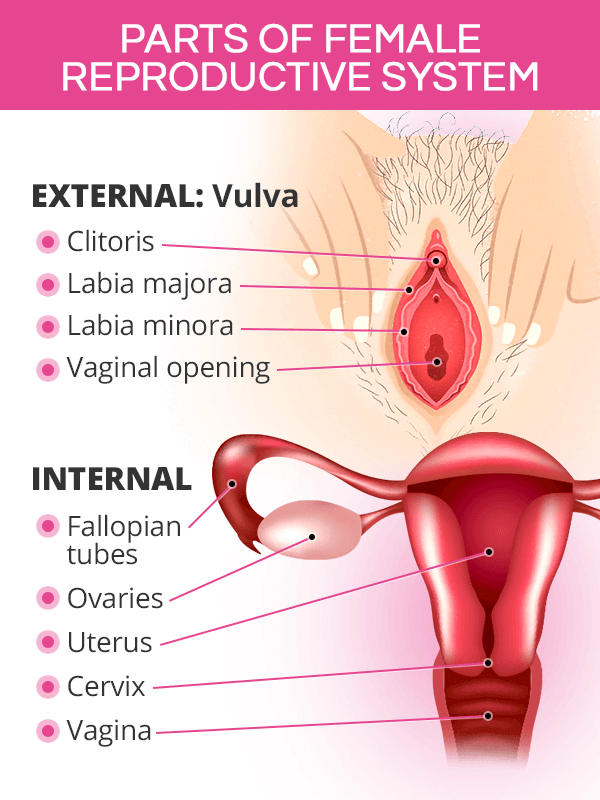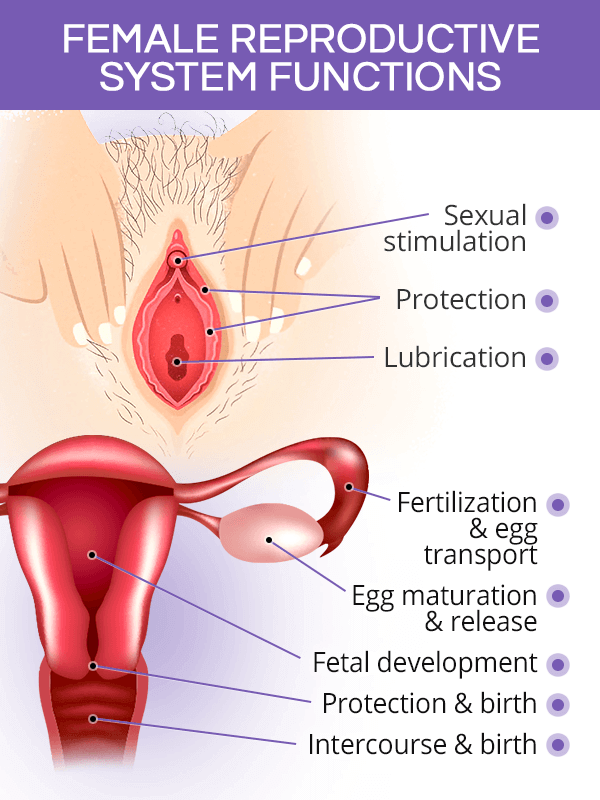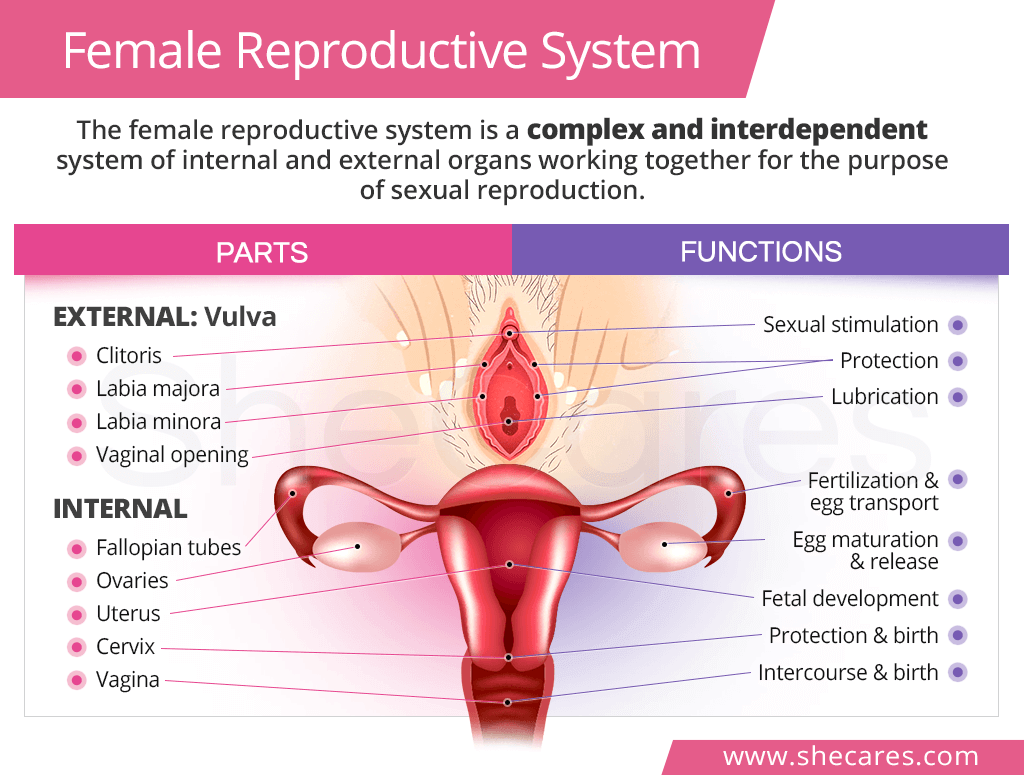Female Reproductive System Anatomy

The individual parts of the female reproductive system can be classified as external and internal. Moving from the most external organs to the most internal ones, women's reproductive anatomy is as follows:
External Female Reproductive Organs
All external female reproductive structures are contained in the vulva, which is made up of the following:
Labia majora are the outermost, fleshy lip-shaped folds where pubic hair grows.
Labia minora are the inner folds within the labia majora that cover the vagina and urethra, the urine duct.
Clitoris is located at the joint of the labia minora folds and is covered with a skin fold called the prepuce.
Vaginal opening with two Bartholin's glands is right below the urethra and above the anus.
Internal Female Reproductive Organs
The internal organs of the female reproductive tract are located in the pelvic cavity and include the following:
Vagina is a stretchy, muscular tube about 3 inches (7.5 cm) long, extending from the vaginal opening to the cervix.1
Cervix is the lower part of the uterus that connects it to the vagina via a small hole, called the os.
Uterus is a hollow, expandable organ lined with the endometrium and located between the bladder and rectum.
Fallopian tubes are two, 4-inch (10 cm) long ducts connecting the uterus to the ovaries.2
Ovaries are small, oval-shaped glands at the end of each fallopian tube.
Female Reproductive System Functions

Now that we have laid out the reproductive structures within the female body, let's take a closer look at the specifics of their functions, or the physiology of the female reproductive system.
Although all organs play key roles in reproduction, we will begin with those structures without which natural conception would not be possible.
Function of the Ovaries
A woman's ability to conceive naturally lies in her ovaries, more specifically in her ovarian reserve, which is a lifetime supply of eggs stored in the ovaries that can be used during ovulation. As such, ovaries' three main functions include:
Produces reproductive hormones, estrogen and progesterone, which guide the entire menstruation
Stores ovarian eggs from birth until menopause
Matures the eggs during the follicular phase of the menstrual cycle
Function of the Fallopian Tubes
Most segments of the fallopian tubes are densely lined with cilia, key, hair-like structures that enable the tubes to serve their three main functions, including:
Allows for sperm passage from the vagina through the uterus and up near the ovary
Serves as locus for fertilization of the egg by the sperm in the tubal part called ampulla
Transports the fertilized or unfertilized egg down to the uterus
Function of the Uterus
The muscles that make up the uterus allow it to expand up to the size of a watermelon during pregnancy, thus allowing it to serve the following four functions:
Accepts the fertilized egg's implantation
Nourishes the embryo until the placenta grows and assumes this function
Houses the developing fetus
Contracts to aid the baby's passage through the birth canal
Function of the Cervix
Although it is technically considered the lower portion of the uterus, the cervix serves its own essential roles to enable conception and subsequent pregnancy development, including the following:
Produces cervical mucus to aid sperm transport up the female reproductive tract
Opens on ovulation to give passage to the sperm into the uterus after ejaculation
Creates a mucus plug that prevents pathogens from entering into the uterus and affecting the fetus
Dilates during childbirth to allow baby's passage from the uterus to the vagina
It is worth mentioning that in the case pregnancy did not occur, the cervix opens during menses to allow the blood and shedding endometrium to leave the body through the vagina.
Function of the Vagina
Vaginal walls are made of muscles and mucus membranes, which - along with mucus-secreting glands - give it its elasticity and flexibility, thus enabling it to fulfill its functions, such as:
Receives the penis during intercourse
Allows for sperm deposition and their passage up the reproductive tract
Serves as the birth canal
Protects the reproductive tract from pathogens
Self-lubricates to facilitate penile penetration
Outside of pregnancy, the vagina allows for menstrual blood to leave the body.
Function of the Vulva
All of the components of the vulva - including the labia majora and minora, clitoris, and vaginal opening - work together to fulfill their sexual and protective functions, such as:
Cushion and protect the external and internal reproductive organs
Participate in vaginal self-cleansing mechanisms
Promote lubrication and sexual pleasure during intercourse
Key Takeaways
Until fully understanding the roles various parts of the female reproductive system play in human procreation, it is easy to take the entire system for granted. Although each of the organs have their unique functions to fulfill, they enable natural conception only when in full collaboration. The innermost reproductive organs, the ovaries, with the hormones they produce, store and mature eggs, one of which is released on ovulation. On the superficial side of the reproductive tract, the vagina receives the penis and sperm deposition, which it then helps transport up through the gatekeeper, or cervix, to the rest of the tract. Then, the fallopian tubes, which connect the ovaries with the uterus, allow for the sperm and the egg to meet and fertilize. Once fertilized, the tubes help carry the egg to the uterus, which is receptive for its implantation and will go through massive transformations to house and nurture the developing baby. At last, upon childbirth, the uterus contracts, and the cervix dilates to facilitate the baby's exit from the mother's body through the vagina.
Sources
- Cleveland Clinic. (2019). Female reproductive system. Retrieved October 31, 2019 from https://my.clevelandclinic.org/health/articles/9118-female-reproductive-system
- Health Direct. (2018). Female reproductive system. Retrieved October 31, 2019 from https://www.healthdirect.gov.au/female-reproductive-system
- Medline Plus. (2018). Female Reproductive System. Retrieved October 31, 2019 from https://medlineplus.gov/femalereproductivesystem.html
- Stat Pearls. (2019). Physiology, Female Reproduction. Retrieved October 31, 2019 from https://www.ncbi.nlm.nih.gov/books/NBK537132/
- Teens Health. (2019). Female Reproductive System. Retrieved October 31, 2019 from https://kidshealth.org/en/teens/female-repro.html
Footnotes:
- Better Health. (n.d.). Reproductive system. Retrieved October 31, 2019 from https://www.betterhealth.vic.gov.au/health/conditionsandtreatments/reproductive-system
- Upstate University Hospital. (n.d.). Evaluation of the Uterus and Fallopian Tubes. Retrieved October 31, 2019 from http://www.upstate.edu/obgyn/healthcare/ivf/eval_fallop.php


